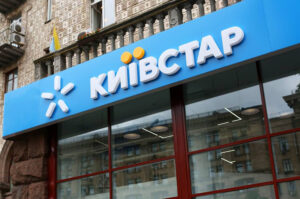
In July-September 2023, Ukraine’s largest mobile operator Kyivstar increased its 4G network coverage, built 600 new base stations and modernized 1.5 thousand base stations, its press service reports.
“In the third quarter of 2023, Kyivstar’s team built another 600 new 4G base stations and modernized almost 1.5 thousand mobile base stations. Another 54 settlements were connected to the 4G network. Currently, Kyivstar’s 4G service is available to 94.7% of the population in the government-controlled areas,” the company said in a statement.
It is also reported that Kyivstar’s capital expenditures for this period exceeded UAH 3.7 billion, which is why more than 99% of the communication network in the government-controlled territory is operating normally. The company plans to invest $600 million in the development of new communication technologies over the next three years.
According to the operator, in the third quarter of this year, subscribers increased the use of mobile Internet services by 17.7% compared to the same period last year. At the same time, the number of 4G users grew by 13.1% to 13.7 million, which was made possible by the development of the 4G network and the proposed tariffs with more megabytes.
At the same time, it is noted that the total number of subscribers in the third quarter decreased by 1.1% due to the impact of war factors, including migration outside the country and the temporary occupation of a number of settlements.
According to the press service, Kyivstar continued to develop digital services for online education, health care, and Kyivstar TV digital television services. According to the company, the number of subscribers using multiservice services increased by 21.4% in the third quarter.
In addition, Kyivstar continued to implement charity projects to help subscribers and Ukrainian society. In particular, the project “We live here” is being implemented, which aims to clear the territory of Ukraine of explosive devices. Thanks to the company’s services, UAH 120 million was raised for this project. At the same time, the operator’s contribution directly exceeded UAH 20 million.
Earlier it was reported that Kyivstar would focus on the development of LTE technology (Long Term Evolution is a wireless network with increased requirements and a bandwidth of 10 Mbps or more.) By 2026, the coverage level in Ukraine will be brought up to 98%.

Ukraine’s largest mobile operator Kyivstar will focus on the development of LTE technology. (Long Term Evolution – wireless network with higher requirements and bandwidth from 10 Mbps), by 2026 the coverage level in Ukraine will be brought to 98%.
“Our goal is to achieve 98% LTE coverage by population by 2026. It’s different now, depending on the region. But, for example, in the Kiev region it is 97%, and on the highway Kiev-Chop 95%”, – said the President of “Kyivstar” Alexander Komarov to journalists.
He specified that increasing the coverage even by 1% requires huge efforts and construction of hundreds of new sites (sites), including greenfield (from scratch, – IF-U).
“Kyivstar is implementing the “LTE everywhere” project in Ukraine, including the $600 million investment from its parent company VEON, Komarov specified.
“We believe that this will be the key technology for the next 5-7 years. It will transmit the largest amount of internet or data of our consumers. That is why we are implementing this project now, and its main focus is coverage”, – specified the president of Kyivstar.
According to him, Kyivstar focuses on three key areas: network development, technology development, and improvement of communication quality. Among other things, Kyivstar is developing PON technology (modern technology of high-speed data transmission via fiber-optic communication lines, which implies connection of all subscribers’ devices through one optical cable and gives an opportunity to simultaneously use several telecommunication services: Internet, TV and telephone – IF-U).
Komarov noted that since new technologies require an increase in the number of sites, through construction, the number of sites has already reached pre-war levels.
“As I said, we are actually building many times more than our competitors – bigger and faster. I will tell you this: despite the loss of 7% of the network (due to the full-scale invasion of the Russian Federation – IF-U) we are currently serving the same number of sites as we were before the war. The part that we lost, we have already fully resumed,” Komarov said.
“Kyivstar is Ukraine’s largest electronic communications operator, serving 24 million mobile subscribers and more than 1.1 million Home Internet subscribers as of September. The company provides services using a wide range of mobile and fixed technologies, including 4G, Big Data, Cloud solutions, services for cyber defense, and digital TV.
Kyivstar’s shareholder is the international VEON group, whose shares are listed on the NASDAQ (New York) and Euronext (Amsterdam) stock exchanges.

Kyivstar, Ukraine’s largest mobile operator, intends to invest up to $10 million in creating an ecosystem of services for patients in the healthcare sector based on Helsi (Healthy Ukraine LLC).
“Our focus is on the development of digital services based on the telecom service we provide to our customers. A good example is our investment in Helsi. We invested in a small company, which at the first stage was an information system for medical institutions and patients. What are we doing now? We are investing to build an ecosystem of healthcare services for patients based on this connection. The investment in Helsi is up to $10 million,” said the president of Kyivstar.
He specified that the funding will be allocated as part of a total investment of about $600 million from the parent company VEON.
According to Komarov, the company is actively developing telemedicine services, which were used by more than 1.1 million people in the first half of 2023. In the near future, it is planned to launch functionality that will allow patients to track test results in the app and sign up for seasonal vaccinations.
Earlier it was reported that Kyivstar invested $3 million in the company’s development after purchasing a controlling stake in Helsi (Healthy Ukraine LLC) in August 2022.
Helsi is a medical information system and a leading digital healthcare provider, known as a provider of SaaS medical information system solutions for 1.3 thousand public and private clinics. “Kyivstar acquired 69.99% in August last year for UAH 555.74 million.
The number of employees has almost doubled to 240 over the past year. In the second quarter of 2023, Helsi increased the number of registered users to 25.4 million patients, up from 25 million a quarter earlier.
As of mid-October 2023, the number of active unique users in the app increased to 1.1 million, and including the web version – to more than 2 million Ukrainians, which is equal to the pre-war figures.
Since the beginning of the year, Helsi has introduced new services: urgent medical consultations, online chat with a doctor and exchange of medical documents, search for doctors and medical facilities nearby, vaccination calendar, and medical certificate service.

Ukraine’s largest mobile operator Kyivstar has invested $3 million in the development of Helsi (Healthy Ukraine LLC) after buying a controlling stake in August 2022, Kyivstar President Oleksandr Komarov said at the Kyiv International Economic Forum.
“Over the year that we have owned (Helsi), we have invested $3 million in the development of this player. The team has grown 2.5 times,” Komarov said.
According to him, the number of telemedicine consultations doubled in 2023.
Helsi is a medical information system and a leading digital healthcare provider in Ukraine with more than 23 million patients and is known as a provider of SaaS medical information system solutions for 1300 public and private clinics. “Kyivstar acquired a 69.99% stake in August last year for UAH 555.74 million.
According to Kyivstar’s report for the second quarter of 2023, Helsi increased the number of registered users to 25.4 million patients, compared to more than 25 million a quarter earlier.
The number of downloads of the Helsi mobile application increased by 0.4 million to 5.4 million in the second quarter, while the number of bookings of doctor’s appointments through the platform remained at approximately 1.8 million for the quarter.

Global digital communications operator VEON (office in the Netherlands) announced the completion of its exit from Russia and the sale of its Russian asset to Vimpelcom. The terms of the deal do not provide for the possibility of repurchase, i.e. the completion of operations in the Russian market is complete and final for VEON
As Kyivstar President Alexander Komarov comments, “after a long series of legal procedures, our 100% shareholder VEON puts an end to its relationship with the Russian telecom market. This will mean strengthening the company’s development strategy in six other markets, including Ukraine”. In particular, in the next three years, VEON plans to invest 600 million dollars in Ukraine, which will be used to restore the telecom network and develop digital services and new mobile technologies.
Oleksandr Komarov emphasized that Kyivstar has been operating as usual, and since the beginning of Russia’s full-scale invasion has already invested UAH 8.2 billion in the development of the country’s telecom market, paid UAH 15.2 billion in taxes to the state, and provided support to state bodies, military, security and law enforcement agencies in the amount of more than UAH 1.4 billion, including bonuses and services without additional payment in the amount of UAH 577 million.
In addition, Kyivstar is now preparing the network to operate in conditions of possible power outages, for which it has invested UAH 988 mln. By the end of 2023, 110 thousand new batteries will be installed at Kyivstar’s base stations.
Background on Kyivstar
Kyivstar is Ukraine’s largest electronic communications operator, serving 24.1 million mobile subscribers and over 1.1 million Home Internet subscribers as of June 2023. The company provides services using a wide range of mobile and fixed technologies, including 4G, Big Data, Cloud solutions, services for cyber defense, digital TV, and others. Kyivstar helps subscribers, society and the country to overcome the difficulties of wartime. Since the beginning of the full-scale war, the company has allocated more than UAH 1.4 billion of assistance to the state, military, society and subscribers. The only shareholder of Kyivstar is the international VEON Group. The Group’s shares are freely traded on the NASDAQ (New York) and Euronext (Amsterdam) stock exchanges. Kyivstar has been operating in Ukraine for over 25 years and is recognized as the largest taxpayer in the telecom market, the best employer and a socially responsible company.

Investments of Ukraine’s largest mobile operator Kyivstar in energy independence amounted to UAH 920 million for the entire period of the full-scale invasion of the Russian Federation, the company’s press service said.
“The national telecom operator prepares in advance for possible winter blackouts and provides the telecom network with diesel generators, long-lasting batteries, uninterruptible power supplies. Since the beginning of the full-scale war Kyivstar has invested UAH 920 mln in energy independence of telecom networks,” the press release says.
In particular, Kyivstar has allocated more than UAH 680 mln for autonomous operation of mobile communications, and for Home Internet – UAH 240 mln.
The company uses more than 2.5 thousand stationary and mobile diesel generators, thanks to which all key base stations, switches and critical telecom equipment have backup power. The base stations are equipped with 37 thousand new long-life batteries, which can operate without external power supply for 4-6 hours.
“Kyivstar plans to install 50 thousand uninterruptible power supply units by the end of the year, which will allow to achieve autonomy of 70% of fixed Internet networks in case of power outages.
The company is also developing energy-efficient GPON technology.
“Development of “Home Internet” network with the use of GPON technology is planned in the fourth quarter of 2023″, – specified in the press service of the company.
Kyivstar communication services are currently used by 24 million subscribers, “Home Internet” services – more than 1 million subscribers.